
Oxydendrum arboreum, the sourwood or sorrel tree, is the sole species in the genus Oxydendrum, in the family Ericaceae. It is native to eastern North America, from southern Pennsylvania south to northwest Florida and west to southern Illinois; it is most common in the lower chain of the Appalachian Mountains. The tree is frequently seen as a component of oak-heath forests.

Disocactus is a genus of epiphytic cacti in the tribe Hylocereeae found in Central America, the Caribbean and northern South America. It should not be confused with Discocactus, which is a different genus.
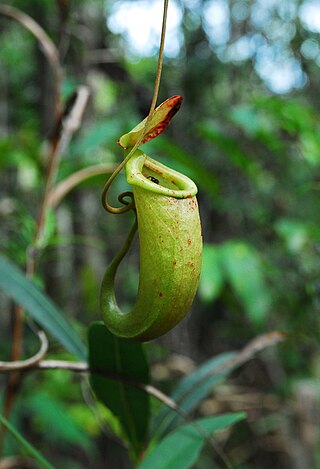
Nepenthes bellii is a tropical pitcher plant endemic to the Philippine islands of Mindanao and Dinagat, where it grows at elevations of 0–800 m above sea level.

Cephalotaxus fortunei, commonly called the Chinese plum-yew, Fortune's yew plum, simply plum yew, Chinese cowtail pine or in Chinese as san jian shan, is a coniferous shrub or small tree in the family Taxaceae. It is native to northern Burma and China, but is sometimes grown in western gardens where it has been in cultivation since 1848.
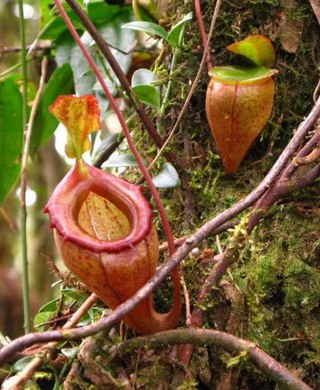
Nepenthes flava is a tropical pitcher plant endemic to northern Sumatra, where it grows in montane forest at 1800–2200 m above sea level.

The mangrove horseshoe crab, also known as the round-tailed horseshoe crab, is a species of horseshoe crab, a chelicerate arthropod found in tropical marine and brackish waters of India, Bangladesh, and Southeast Asia. It may also occur in Sri Lanka, Myanmar and the Philippines, but confirmed records are lacking. It is the only species in the genus Carcinoscorpius.

Tachypleus tridentatus, commonly known as the Chinese horseshoe crab, Japanese horseshoe crab, or tri-spine horseshoe crab, is a species of horseshoe crab found in Southeast and East Asia, with records from China, Indonesia, Japan, South Korea, Malaysia, the Philippines, Taiwan, and Vietnam. It is found in coastal marine and brackish waters, and tolerates colder temperatures than the other Asian horseshoe crabs, although juveniles still need water warmer than 22 °C (72 °F) to moult.

Mimetes arboreus, or Kogelberg pagoda, is an evergreen, upright large shrub or small tree of 2–6 m (6½–20 ft) high in the family Proteaceae. It grows from a thick trunk with a smooth grey bark that branches at ½–1 m (1½–3 ft) above the ground. It has silvery, lance-shaped, pointy leaves of 5–8¼ cm (2.0–3.3 in) long and ¾–3¼ cm (0.3–1.3 in) wide, at an upward angle and overlapping each other. The inflorescences are set just below the top of the branches, are cylinder-shaped, 8–10 cm in diameter, topped by a crest of more or less horizontal pinkish or reddish tinged leaves. It consists of several flower heads in the axils of pinkish orange leaves that form a hood shielding the underlying flower head. Each flower head contains eight to thirteen individual flowers, with bright red styles and grey silky perianth lobes. It is endemic to the Fynbos ecoregion of South Africa, being confined to the Kogelberg mountain range.

Xylosma hawaiensis is a species of flowering plant in the family Salicaceae, that is endemic to Hawaii. Common names include Hawai'i brushholly, maua, and aʻe.
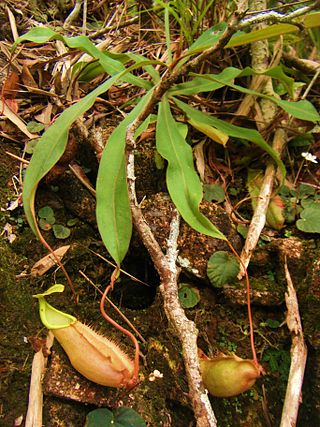
Nepenthes chang is a tropical pitcher plant endemic to the Banthad Mountains of eastern Thailand, where it grows at elevations of 300–600 m above sea level. It is thought to be most closely related to N. kampotiana.

Tachypleus gigas, commonly known as the Indo-Pacific horseshoe crab, Indonesian horseshoe crab, Indian horseshoe crab, or southern horseshoe crab, is one of the four extant (living) species of horseshoe crab. It is found in coastal water in South and Southeast Asia at depths to 40 m (130 ft).
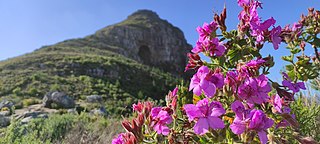
Pelargonium cucullatum is a hairy, upright, branching, perennial shrub, of 1–2 m (3.3–6.6 ft) high, that has been assigned to the cranesbill family. It sprouts new stems from the underground rootstock and becomes woody at its base. It has alternately set, sometimes slightly succulent leaves crowded near the top of the branches, with leaf stalks and flat to hood-shaped leaf blades, with a rounded broad triangular to kidney-shaped outline of about 4–5.5 cm long and 5–9 cm wide, often somewhat incised, the margin with irregular teeth. The white to purplish red, 5-merous, somewhat mirror symmetrical flowers grow in umbel-like clusters, and each contain mostly 7 fertile stamens and 3 infertile staminodes of different length. P. cucullatum has been cultivated as a garden ornamental and house plant since the 17th century. It has been used to breed many modern pelargonium hybrids, notably the Regal pelargoniums. It is called hooded-leaf pelargonium or herba althaea in English and wildemalva in Afrikaans.
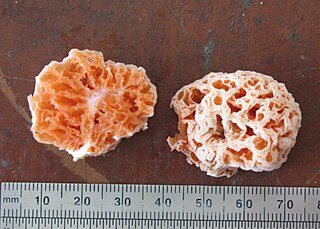
Spongiforma squarepantsii is a species of fungus in the family Boletaceae, genus Spongiforma. Found in Malaysia, it was described as new to science in 2011. It produces sponge-like, rubbery orange fruit bodies that have a fruity or musky odour. The fruit bodies reach dimensions of 10 cm (3.9 in) wide by 7 cm (2.8 in) tall. Like a sponge, they will resume their original shape if water is squeezed out. The spores, produced on the surfaces of the hollows of the sponge, are almond-shaped with rough surfaces, and measure 10‑12.5 μm by 6‑7 μm. The name of the fungus derives from the Nickelodeon cartoon character SpongeBob SquarePants from the show of the same name SpongeBob SquarePants. S. squarepantsii is one of two species in Spongiforma; it differs from S. thailandica in its color, odour, and spore structure.

Lyreidus is a genus of crabs in the family Raninidae, containing the following species:
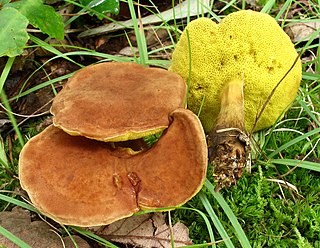
Aureoboletus innixus is a species of bolete fungus in the family Boletaceae. Found in eastern North America, it was first described scientifically by Charles Christopher Frost in 1874, from collections made in New England. An edible mushroom, the convex cap grows to 3–8 cm (1.2–3.1 in) wide and is dull reddish brown to yellow brown. The stem is 3–6 cm (1.2–2.4 in) long by 1–1.6 cm (0.4–0.6 in) thick, but often swollen at the apex with a tapered base. It has a bright yellow pore surface when young that dulls in color when mature. There are about 1 to 3 pores per mm when young, but they expand as they mature to about 2 mm wide. The spore print is olive-brown, and the spores are ellipsoid, smooth, and measure 8–11 by 3–5 um.

Boletus abruptibulbus is a species of bolete mushroom in the family Boletaceae. Described as new to science in 2009, it is found only in the Gulf Coast of the Florida Panhandle, where it grows on the ground in coastal sand dunes, one of only three North American boletes known to favor this habitat. The fruit bodies have convex brownish caps up to 8 cm (3.1 in) in diameter, supported by solid yellowish to reddish stems measuring 3–5 cm (1.2–2.0 in) long by 10–15 mm (0.4–0.6 in) thick. The pores on the underside of the cap measure about 1–2 mm in diameter and are initially pale yellow before developing a greenish tinge in age. The mushroom's spores, about 20 micrometers long, are unusually long for a member of the Boletaceae. The stem base is bulbous, a diagnostic feature for which the species is named.

Lepiota castaneidisca is a species of agaric fungus in the family Agaricaceae. Formally described in 1912, it was for a long time considered the same species as the similar Lepiota cristata until molecular analysis reported in 2001 demonstrated that it was genetically distinct. It is most common in coastal and northern California, and has also been recorded in Mexico. A saprobic species, it is usually found under redwood and Monterey cypress. Its fruit bodies (mushrooms) have white caps with an orange-red to orange-brown center that measure up to 3.2 cm (1.3 in) wide. The cream-colored to light pink stems are up to 6.5 cm (2.6 in) long by 0.2–0.6 cm (0.1–0.2 in) thick, and have a ring. L. castaneidisca can be distinguished from other similar Lepiota species by differences in habitat, macroscopic, or microscopic characteristics.

Caladenia amoena, commonly known as charming spider orchid, is a plant in the orchid family, Orchidaceae, and is endemic to Victoria, Australia. It is a ground orchid which grows singly or in small groups, has a single dark green, hairy leaf and a single yellowish-green flower with red stripes. It is only known from a few sites and has been classified as Endangered.
Hypericum cuisinii is a perennial herb in the genus Hypericum, in the section Adenosepalum. The herb has pale yellow flowers and occurs in Greece and Turkey.
Stenanthemum tridentatum is a species of flowering plant in the family Rhamnaceae and is endemic to the southwest of Western Australia. It is a prostrate to upright shrub with sparsely hairy young stems, egg-shaped to fan-shaped leaves, and creamy white or creamy-yellow flowers arranged singly or in groups of up to three.


















